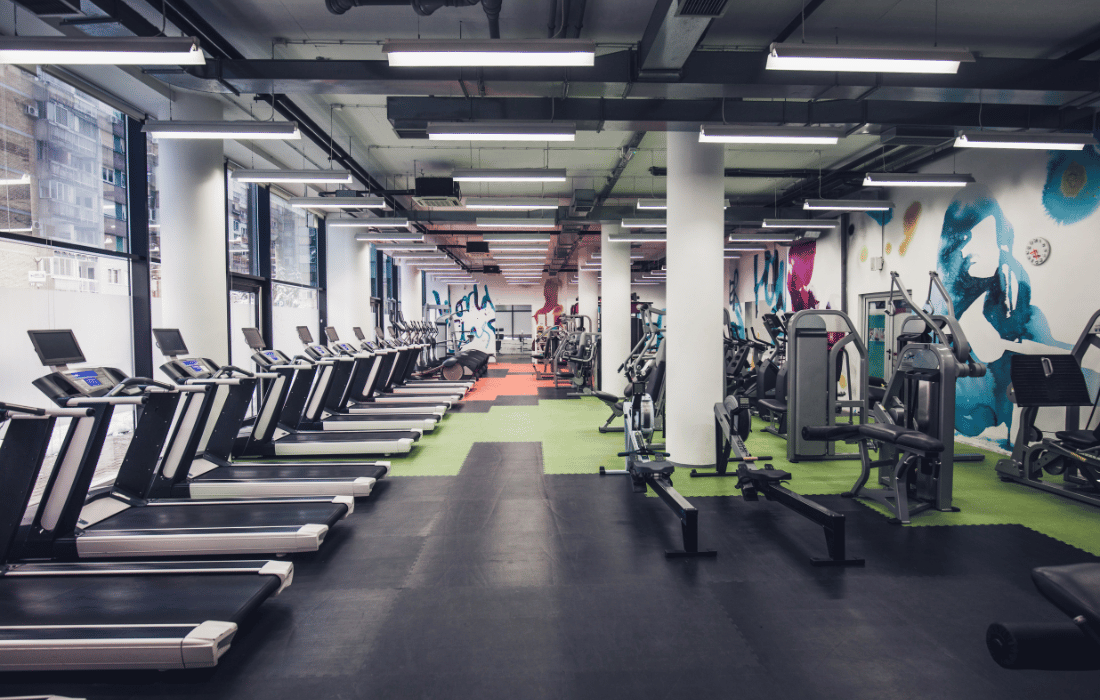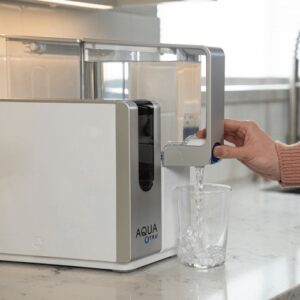When we step into a gym, the goal is simple: to improve our health, build strength, and push our physical limits. But what if the very space meant to enhance our well-being is also quietly undermining it? Modern gyms are not just filled with weights and cardio machines—they are also hubs for silent disruptors like electromagnetic fields (EMFs), harsh artificial lighting, toxic cleaning chemicals, and more. These hidden dangers are often overlooked, but they are ever-present, creating a bit of an oxymoron: you’re going to the gym to get healthier, but the environment itself could be doing the opposite.
Gyms are filled with some of the highest concentrations of these disruptors, much like airports, shopping malls, and office buildings. The difference is that we typically enter gyms with the explicit purpose of improving our physical health, making it even more concerning that these stressors go largely unnoticed and unaddressed. The high-tech fitness equipment, constant Wi-Fi, Bluetooth connections, and industrial cleaning products all contribute to a health risk that we’re seldom aware of, but it’s one that can have serious consequences over time.
In this guide, we’ll explore the most common silent disruptors in gyms and how they can affect your health and performance. More importantly, we’ll cover actionable strategies to protect yourself and create a healthier environment for your workouts, so your efforts to improve your fitness aren’t quietly sabotaged by the very space designed to help you.
Why Endocrine Disruptors Matter for Athletes
For most people, the gym is synonymous with physical stress—a place to challenge your body and push limits. But for athletes, it’s also a place that can bombard your body with invisible stressors, draining energy and hampering recovery. Overstimulation occurs when the sensory inputs in your environment—like light, sound, and electromagnetic radiation—overload your system, making it harder for your body to recover and perform optimally. This can show up as poor sleep, chronic fatigue, reduced focus, and even slower recovery times.
The combination of factors like EMF exposure, artificial lighting, and noise pollution can make it difficult for your body to shift into recovery mode, meaning that even though you’re working hard, your body might not be getting the rest and repair it needs. Over time, this can lead to burnout, overtraining, or even injury.
1. Understanding EMF Exposure in the Gym
EMFs, or electromagnetic fields, are invisible areas of energy generated by both natural and man-made sources. In gyms, EMFs primarily come from Wi-Fi routers, Bluetooth devices, and electrical equipment like treadmills, elliptical machines, and stationary bikes. Though the science is still emerging, numerous studies suggest that long-term EMF exposure can contribute to oxidative stress, interfere with sleep, and impair cellular function.
For athletes, this is particularly important because recovery and cellular regeneration are vital to performance. Oxidative stress from EMF exposure can increase inflammation in the body, slow down the healing process, and exacerbate physical strain from training.
How to Manage EMF Exposure:

Save 25% on Aires Tech EMF protection with code “MOL” Use EMF Protection Devices: Products like Aires Tech Lifetune devices are designed to neutralize harmful EMF exposure. These devices can be worn on your body or attached to your gym gear to create a protective field around you, minimizing the impact of EMFs. For instance, you can place the Lifetune Go in your gym bag or pocket or attach the Lifetune One to your wireless headphones for additional protection during your workout.
Airplane Mode: If you rely on your phone for music or tracking your workout, switch your phone to airplane mode to cut off Wi-Fi and Bluetooth signals during your session. You can still listen to music stored on your device while minimizing unnecessary EMF exposure.
Limit Wireless Tech Usage: If you’re using fitness trackers or wireless headphones, consider taking breaks from them during workouts, or opting for wired alternatives. Fitness trackers can be synced after your workout, rather than constantly transmitting data, which reduces your overall EMF load.
Outdoor Training: Whenever possible, move parts of your workout outdoors, where you’re less exposed to high concentrations of EMFs. Outdoor workouts also come with the added benefit of natural sunlight, which can help counteract some of the negative effects of artificial lighting indoors.
2. Tackling Artificial Lighting in the Gym
Many gyms are equipped with harsh fluorescent or LED lighting, which emits high levels of blue light. Blue light disrupts melatonin production—the hormone that helps regulate your sleep-wake cycle—and can contribute to poor sleep quality if you’re exposed to it during late-day workouts. Over time, this disruption can impair recovery, reduce your energy levels, and lead to chronic fatigue.
For athletes, proper sleep is non-negotiable. It’s during sleep that your body repairs damaged tissues, restores energy levels, and clears metabolic waste from the brain.
Strategies for Reducing the Impact of Artificial Lighting:

Ra Optics Blue Light Blocking Glasses Blue-Light Blocking Glasses: These glasses filter out the harmful blue light emitted from fluorescent and LED lighting. Wearing them during your workout—especially if you train early in the morning or late at night—can help protect your body’s natural melatonin production. This is especially useful for evening workouts when your body needs to start winding down for sleep.
Natural Light Exposure: If your gym has windows or skylights, try to position yourself near these areas to absorb more natural light. Natural sunlight helps regulate your circadian rhythm, which boosts mood, energy, and recovery.
Outdoor Workouts: One of the best ways to counteract the effects of artificial lighting is to take parts of your training outside. Sunlight provides a spectrum of light that helps your body produce vitamin D and improves your mood and recovery. Outdoor sessions can give you a break from the harsh lighting indoors and allow you to reconnect with natural rhythms.
3. Improving Air Quality in Gym Environments
Most gyms don’t put much thought into air quality, but the combination of poor ventilation, sweat, dust, and harsh cleaning agents can create a toxic environment. The air you breathe during an intense workout matters—your respiratory system is already under strain, and breathing in poor-quality air can slow your recovery and contribute to inflammation.
How to Improve Air Quality:

AirDoctor Home Air Purifier I nvest in Air Purification: In your home gym, installing high-quality air purifiers can significantly improve air quality by removing airborne particles, allergens, and toxins. In public gyms, you’re more limited in what you can control, but you can still seek out areas that are well-ventilated or closer to windows.
Step Outside for Fresh Air: Taking short breaks outdoors between sets or after your workout can help you clear your lungs and get a break from recycled, stale gym air. Even a few deep breaths of fresh air can make a difference, especially after a high-intensity session.
Outdoor Training: Whenever possible, conduct parts of your training outdoors. Fresh air is an underutilized tool for recovery and performance. Training in a well-ventilated space or outside reduces the toxins your body is exposed to, which can enhance both endurance and post-workout recovery.
4. Minimizing Chemical Exposure from Cleaning Agents
Public gyms often rely on industrial-grade cleaning products that contain harsh chemicals like chlorine, ammonia, and quaternary ammonium compounds (quats). These chemicals can linger on gym equipment, get absorbed through your skin, and even linger in the air you breathe. Over time, regular exposure to these toxins can lead to skin irritation, hormone disruption, and respiratory issues.
How to Avoid Harmful Chemicals:
Bring Your Own Wipes: One simple but effective way to reduce your exposure to harsh chemicals is to bring your own non-toxic cleaning wipes. Use these to wipe down gym equipment before and after you use it to ensure you’re not coming into contact with chemical residues.
Use Towels: Bring your own towels to lay over benches, machines, or mats before using them. This minimizes direct contact with potentially toxic surfaces, especially after they’ve been cleaned with strong disinfectants.
Ask About Eco-Friendly Cleaning Products: If you’re a regular at a particular gym, ask the management about switching to eco-friendly cleaning products. More and more gyms are adopting greener practices, and it’s worth having that conversation if you want to protect yourself and other gym-goers.
5. Hydration and Water Quality
Proper hydration is critical to performance and recovery, but not all water is created equal. Many gyms rely on tap water, which can contain chemicals like chlorine, fluoride, and even trace amounts of pharmaceuticals or heavy metals. These contaminants can interfere with your hydration and even have long-term effects on your health.
How to Ensure Clean Hydration:
 Bring Purified Water: Always bring your own glass bottle filled with purified water to the gym. Investing in a home purification system ensures that the water you drink during your workout is free from contaminants like chlorine, heavy metals, and harmful chemicals. For athletes, staying hydrated with pure, clean water is just as important as the workout itself.
Bring Purified Water: Always bring your own glass bottle filled with purified water to the gym. Investing in a home purification system ensures that the water you drink during your workout is free from contaminants like chlorine, heavy metals, and harmful chemicals. For athletes, staying hydrated with pure, clean water is just as important as the workout itself.Look for Filtered Water Stations: Some gyms offer filtered hydration stations, which can provide cleaner water than regular tap sources. Use these whenever possible to minimize exposure to chemicals and toxins.
Electrolyte Balance: After high-intensity or long-duration workouts, ensure you’re replenishing not just water, but also essential electrolytes like sodium, potassium, and magnesium. Many athletes neglect this part of hydration, leading to suboptimal performance and prolonged recovery times.
6. Managing Sound and Electromagnetic Overstimulation
Noise pollution is another form of dysregulation that’s easy to overlook. Gyms are often filled with clanking weights, loud music, and constant chatter—all of which can elevate stress levels and make it difficult to focus during your workout. For athletes who thrive on focus and intensity, this can be a huge disruptor.
How to Manage Noise Pollution:
 Noise-Canceling Headphones with EMF Protection: Wearing noise-canceling headphones can help block out background noise, allowing you to focus on your workout. Pair these with EMF protection (like Aires Tech Lifetune One and Lifetune Go devices) to block both the noise and harmful wireless signals, creating a more serene workout environment.
Noise-Canceling Headphones with EMF Protection: Wearing noise-canceling headphones can help block out background noise, allowing you to focus on your workout. Pair these with EMF protection (like Aires Tech Lifetune One and Lifetune Go devices) to block both the noise and harmful wireless signals, creating a more serene workout environment.Train During Off-Peak Hours: If you’re able to, plan your workouts during off-peak hours when the gym is less crowded and quieter. Fewer people often means less noise and a more focused training session. In many gyms, early mornings or late evenings are the least busy.
Breathwork & Mindfullness: In moments where you can’t control the distraction, practice breathing exercises or meditation techniques to center your focus. Box breathing or diaphragmatic breathing between sets can help you tune out distractions and stay focused on the task at hand.
Bringing It All Together: Blending Nature and Technology
In today’s gym environment, it’s nearly impossible to avoid all sources of overstimulation. But by taking proactive steps—whether it’s using EMF protection, improving air quality, or switching to filtered water—you can significantly reduce the negative effects these disruptors have on your body.
Athletes, in particular, can benefit from mastering their training environment. Whether you’re training in a high-tech gym or in your own home setup, the goal is to blend the benefits of modern technology with the healing qualities of nature. For me, this philosophy is embodied in my personal training space, to the moon dojo, but the same principles can be applied anywhere.
By learning to control your environment, you’ll not only improve your performance in the gym but also protect your long-term health, ensuring that you can continue pushing limits and achieving your goals for years to come.












